Hell Courtesan
Hell Courtesan (Japanese: 地獄太夫, romanized: Jigoku Dayū) is a legendary figure originating in Edo Japanese folklore. The Hell Courtesan has been portrayed multiple times in ukiyo-e.[1]
Legend
The Hell Courtesan is usually depicted in a dress with the images of hell,[2] the souls of those she condemned,[3] Emma-Ō (one of the kings of hell),[3][1] horned demons,[1] and bodhissatvas.[1] Kawanabe Kyōsai is depicted on her dress, or sometimes "Hotei (one of the Seven Gods of Good Fortune) in the guise of Jizō, the guardian of children, travelers, and the underworld. Other depictions include karako (a Chinese child motif that represents prosperity of the family and its posterity), in which the children stack jewels.[4]
The legend was about a beautiful courtesan, a daughter of a samurai, who was "kidnapped by his enemies and was sold to a brothel".[3] She started to call herself "Hell Courtesan" after an encounter with a Buddhist monk, Ikkyu Sojun, who was known for his taste for sake and prostitutes. According to the story, Ikkyū met the Hell Courtesan during one of his visits to the pleasure district. Santō Kyōden's book from 1809,[5] All Records of Drunken Enlightenment of Our Country, tells that she "found him dancing with a bunch of skeletons instead of being entertained by dancers and geisha. It occurred to her that he may not be an ordinary human being."[4] She then became his disciple and achieved enlightenment. The story first appeared in 1672, in the anonymously written book Ikkyū kantō banashi.[6][5]
Dayu was the highest rank of a courtesan, and Jigoku means not only hell, but the homonym also meant "the lowest streetwalker prostitute in the Edo period".[6]
Gallery
.jpg.webp) Kawanabe Kyōsai, Hell Courtesan, Ikkyu, and Skeletons, 1880.[4]
Kawanabe Kyōsai, Hell Courtesan, Ikkyu, and Skeletons, 1880.[4]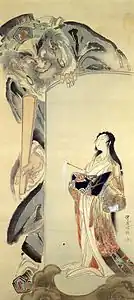 Kawanabe Kyōsai, "Emma and the Hell Courtesan"[5]
Kawanabe Kyōsai, "Emma and the Hell Courtesan"[5]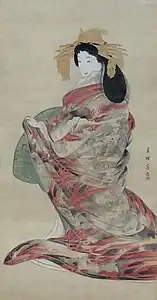 Unknown author, The Hell Courtesan[1]
Unknown author, The Hell Courtesan[1] Toyohara Kunichika, Thirty-six Good and Evil Beauties: Jigoku Dayu[3]
Toyohara Kunichika, Thirty-six Good and Evil Beauties: Jigoku Dayu[3]_late_1840s_by_Utagawa_Kuniyoshi.jpg.webp)
.jpg.webp) Tsukioka Yoshitoshi, The Buddhist monk Ikkyu holding a skull before the courtesan Jigoku-dayu
Tsukioka Yoshitoshi, The Buddhist monk Ikkyu holding a skull before the courtesan Jigoku-dayu.jpg.webp) Utagawa Kuniyoshi, Scene from a kabuki play. The kabuki actor Nakamura Shikan (Utaemon IV) as Ikkyu Taro (left) holding down an opponent, extends his sword towards Segawa Kikunojo (right) as the courtesan, Jigoku-dayu
Utagawa Kuniyoshi, Scene from a kabuki play. The kabuki actor Nakamura Shikan (Utaemon IV) as Ikkyu Taro (left) holding down an opponent, extends his sword towards Segawa Kikunojo (right) as the courtesan, Jigoku-dayu.jpg.webp) Utagawa Kuniyoshi, Top: Ecchu Province: the Zen monk Ikkyu Zenji with a young attendant and the courtesan Jigoku Dayu kneeling outside.
Utagawa Kuniyoshi, Top: Ecchu Province: the Zen monk Ikkyu Zenji with a young attendant and the courtesan Jigoku Dayu kneeling outside._(BM_2008%252C3037.15503).jpg.webp) Utagawa Kuniyoshi, The courtesan Jigoku-dayu seated on a throne, holding a Buddhist fly-whisk
Utagawa Kuniyoshi, The courtesan Jigoku-dayu seated on a throne, holding a Buddhist fly-whisk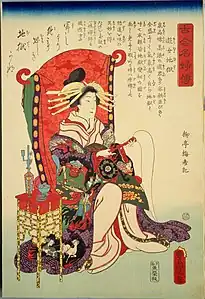 Utagawa Kunisada, from the picture album "Toyokuni Nishiki-e shu"
Utagawa Kunisada, from the picture album "Toyokuni Nishiki-e shu"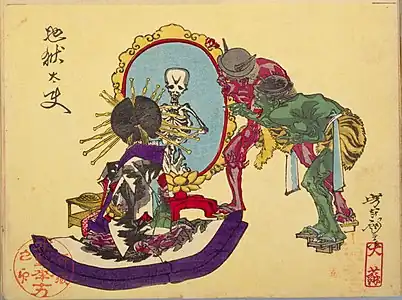
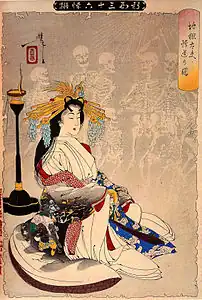 Tsukioka Yoshitoshi, The Enlightenment, February 1890. From the Thirty-six Ghosts series.
Tsukioka Yoshitoshi, The Enlightenment, February 1890. From the Thirty-six Ghosts series.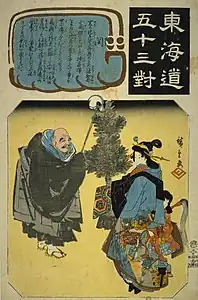 Hiroshige, "The 53 stations of the Tōkaidō in pairs"
Hiroshige, "The 53 stations of the Tōkaidō in pairs".jpg.webp)
References
- "The Hell Courtesan late 19th century". www.metmuseum.org. Retrieved 4 November 2022.
- "Seduction: Japan's Floating World". www.asianart.com. Retrieved 4 November 2022.
- "Kunichika, 36 Good and Evil Beauties - Jigoku Dayu". The Toshidama Gallery. Retrieved 4 November 2022.
- "An Auspicious Kind of Hell". 31 October 2018. Retrieved 4 November 2022.
- "Who is the Hell Courtesan?" (in Japanese). Retrieved 4 November 2022.
- Avilés, Ernult José Rodolfo (2021). "The uncanny and the superflat in macabre representations: Iconographic analysis of a Kawanabe Kyosai blockprint" (PDF). Ritsumeikan Journal of Asia Pacific Studies. 39 (1): 58-80. Retrieved 21 March 2023.
- Zumel, Nina (18 May 2015). "Ikkyū and the Hell Courtesan". Multo (Ghost).
- "Jigoku dayu (Hell Courtesan) - Kawanabe Kyōsai". Google Arts & Culture. Retrieved 4 November 2022.